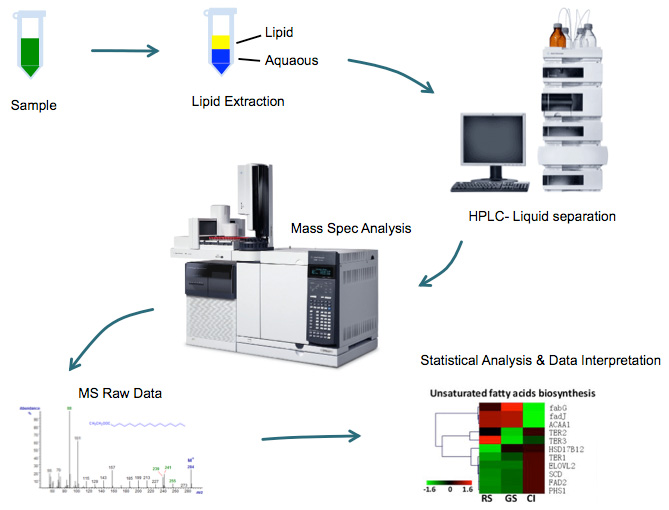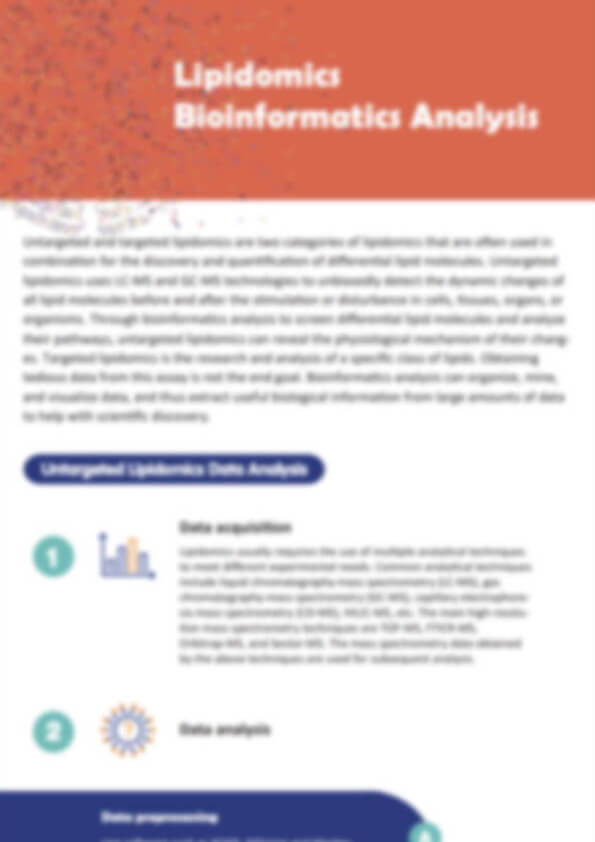- Service Details
- Demo
- Case Study
- FAQ
- Publications
Why should do Yeast Lipidomics Profiling
Yeast, particularly Saccharomyces cerevisiae, has emerged as a reliable model organism for lipid research, offering numerous advantages for studying lipid biochemistry, molecular biology, and cell biology.With its simplified lipidome and conserved lipid metabolic pathways, yeast provides an ideal platform for studying lipid function and metabolism. Additionally, its fatty acid composition is relatively simple, primarily consisting of fatty acids with 16 or 18 carbon atoms, most of which are monounsaturated, making the study of lipid structure and function more straightforward in untargeted lipidomic and targeted lipidomic analysis. The genetic tractability and ease of experimentation in yeast make it an ideal system for studying lipid homeostasis and metabolism, with insights that are broadly applicable to other eukaryotic organisms.
Even though lipid metabolism is different from their mammalian counterparts in some cases, for example, ergosterol, which is synthesized in a complex series of condensation, cyclization, and redox reactions from C5 (isoprene) backbone, is the major sterol in yeast instead of cholesterol. Nevertheless, the yeast model system offers a great opportunity to manipulate proteins that control the synthesis, turnover, localization and degradation of specific lipid species. Yeast membranes has been shown to be very sensitive to different types of stress, such as D-limonene stress, salt stress, hypoxic stress, and nutrient stress. The change of membrane lipidome was suggested to play an important role in stress adaptation.
Yeast Lipidomics Profiling Technologies
With the development of Mass spectrometry methodology, yeast lipidome can be profiled as a whole with increasing accuracy and sensitivity. The instrumentation useful for the identification and quantification of yeast lipidomics includes MS, GC, HPLC, or LC-MS, GC-MS. The coupling of chromatographic methods such as GC or HPLC with MS can greatly increase coverage of lipids. As one of the widely used analytical techniques in yeast lipidomics, LC-MS is utilized to qualitatively and quantitatively analyze a wide range of lipid species in yeast. Additionally, profiling of yeast lipids by Shotgun Lipidomics has emerged as a powerful approach, enabling comprehensive lipidomic analysis without the need for prior chromatographic separation.
Yeast Untargeted Lipidomics Services in Creative Proteomics
With integrated set of separation, characterization, identification and quantification systems featured with excellent robustness & reproducibility, high and ultra-sensitivity, Creative Proteomics provides reliable, rapid and cost-effective yeast untargeted lipidomics with LC-MS and GC-MS analysis.
Our mass spectrometry lipidomics analysis can analyze a wide range of substances, providing both qualitative and quantitative insights into various lipids, including phosphatidylserine (PS), phosphatidylinositol (PI), phosphatidylcholine (PC), phosphatidylethanolamine (PE), and phosphatidic acid (PA).
Analysis Workflow
 Figure 1. Workflow of yeast untargeted lipidomics analysis.
Figure 1. Workflow of yeast untargeted lipidomics analysis.
Sample Submission Requirements
Sample Requirements: Use fresh or frozen yeast cells in the logarithmic growth phase, with a minimum of 1×10⁷cells per sample.
Storage: Avoid repeated freeze-thaw cycles and store samples at -80°C.
Shipping: Samples must be shipped on dry ice to maintain low temperatures during transport.
Contamination: Ensure samples are free of contaminants.
Total Yeast Lipid Extraction Method
The total yeast lipid extraction method primarily uses liquid-liquid extraction, with the Folch method (chloroform-methanol mixture) being ideal for nonpolar lipids like triglycerides, and the Bligh and Dyer method, with higher methanol content, better suited for polar lipids like glycerophospholipids. Recent advancements include the use of methyl-tert-butyl ether for reduced toxicity and improved sample handling. For polar anionic lipids, an acidified Bligh and Dyer method is recommended, with careful control of HCl concentration and extraction time to avoid hydrolysis.
How to place an order


PCA plot

Heatmap plot

Volcano plot

Correlation dot plot
Title: Comparative Lipidomics of Different Yeast Species Associated to Drosophila suzukii
Journal: Metabolites
Published: 2022
Background
This study investigates the lipidomic profiles of yeasts associated with Drosophila suzukii (spotted wing drosophila, SWD), a major agricultural pest. Yeasts, as a nutritional source for SWD, produce volatile compounds and lipids that attract and stimulate feeding in these insects, which makes them pivotal in understanding the insect-microbe interactions. Specifically, the research compares the lipid compositions of five yeast species, including Hanseniaspora uvarum, Saccharomyces cerevisiae, and others, isolated from grapes infested by SWD. The study employs untargeted lipidomic analysis to uncover the differences in lipid profiles, with a particular focus on non-polar metabolites. The findings highlight the biochemical diversity of yeast species and their potential role in modulating SWD behavior, providing valuable insights into the ecological and metabolic factors influencing SWD's interaction with yeast. This work contributes to the understanding of yeast lipidomics in the context of insect behavior and offers implications for developing biocontrol strategies by exploiting yeast-insect interactions.
Materials & Methods
Yeast Cultivation and Lipid Extraction
Seven yeast strains, including Saccharomyces cerevisiae S288c, were grown in Potato Dextrose Broth (PDB) for 30 hours at 25°C. After culturing, yeast cells were harvested, frozen, and freeze-dried. Lipids were then extracted using a methanol-MTBE mixture with added internal standards to ensure accuracy.
Chromatographic and Mass Spectrometric Analysis
The extracted lipids were analyzed using high-performance liquid chromatography (HPLC) on a C18 column, connected to a mass spectrometer (QTOF). The analysis was conducted in both positive and negative ion modes to identify different lipid species, using specific solvents like acetonitrile, water, and isopropanol.
Data Processing and Statistical Analysis
Data was processed using MS-DIAL software for peak detection and lipid identification. The statistical significance of lipid differences was evaluated using methods like ANOVA and pairwise testing in SPSS. Lipid data was stored in the EMBL-EBI MetaboLights database for future reference.
Results
Compound Annotation and Differences in the Lipid Profiles
The hierarchical clustering analysis revealed that biological variability is smaller compared to species differences, as indicated by the clustering results. Two main clusters were identified.Notably, the three H. uvarum strains clustered closely, showing high lipid profile similarity. Despite some strains belonging to the same family (e.g., S. cerevisiae and I. t. 2.1), the clustering did not align strictly with taxonomic relationships, likely due to the influence of growth conditions and medium composition on lipid metabolism.
 Figure 6.A hierarchical clustering dendrogram based on Spearman distance and Ward's method
Figure 6.A hierarchical clustering dendrogram based on Spearman distance and Ward's method
Compound Classes Responsible for Discrimination between Yeast Species
A principal component analysis (PCA) revealed distinct clusters among six yeast species/strains based on their lipid profiles, with 171 metabolites analyzed. The three strains of H. uvarum showed low variability, supporting previous findings of minimal differences within this species. The first two principal components explained 64.5% of the lipid profile variation, with key influences from polyunsaturated fatty acids (PUFAs) and ergosterol. A multivariate analysis of variance (MANOVA) confirmed significant differences in the lipid profiles between most species, except for some strains of H. uvarum. The results indicate clear lipidomic distinctions among the yeast species.
 Figure 7. PCA and MANOVA analysis of lipid profiles in six yeast species
Figure 7. PCA and MANOVA analysis of lipid profiles in six yeast species
Differences in the Lipid Profile of GP, DG and TG
The lipid analysis of yeast samples, visualized through heatmaps, highlighted differences in phospholipid classes, particularly glycerophospholipids (GPs), diacylglycerols (DGs), and triacylglycerols (TGs). The three H. uvarum strains showed similar lipid profiles, while C.sp. 3.3 and M.p. 3.2 were richer in GPs. The heatmap also revealed that S. cerevisiae S288c had fewer GPs containing polyunsaturated fatty acids (PUFAs). TGs were useful for differentiating H. uvarum from S. cerevisiae, with significant differences in their profiles. Additionally, the presence of odd-numbered fatty acids in TGs, PCs, and LPCs was observed in C.sp. 3.3, M.p. 3.2, and S.v. 1.33, with S.v. 1.33 showing the highest levels of TGs containing odd-numbered fatty acids, which serves as a distinguishing feature between species.
 Figure 8. The heatmaps display the distribution of GPs, DGs, and TGs across different yeast species and strains
Figure 8. The heatmaps display the distribution of GPs, DGs, and TGs across different yeast species and strains
Conclusion
This study explores the impact of yeast strain lipid profiles on the behavior of SWD flies, focusing on their feeding preferences. Using an untargeted approach, 171 metabolites were annotated across yeast species associated with SWD. The results highlight significant lipid profile differences, particularly in TG, DG, FA, and GP, and their potential role in SWD fly attraction. These findings lay the foundation for further behavioral and entomological research on yeast-insect interactions.
Reference
- Bianchi, F., Spitaler, U., Robatscher, P., Vogel, R. F., Schmidt, S., & Eisenstecken, D. (2020). Comparative Lipidomics of Different Yeast Species Associated to Drosophila suzukii. Metabolites, 10(9), 352. https://doi.org/10.3390/metabo10090352
How do you extract lipids from yeast?
Lipid extraction from yeast typically involves solvent-based methods like the Folch, Bligh and Dyer, or modified Folch protocols. These methods use organic solvents, such as chloroform and methanol, to separate lipids from the yeast cells. After cell lysis, the lipids are isolated from the aqueous phase and then analyzed. For lipidomics studies, it's important to use a procedure that efficiently extracts both polar and non-polar lipids for comprehensive profiling.
What is the difference between targeted and untargeted lipidomics?
Targeted lipidomics focuses on measuring predefined lipid species that are known to be of interest. This approach uses specific standards and assays to quantify a select group of lipids. Untargeted lipidomics, on the other hand, aims to identify and quantify all lipid species present in a sample without prior knowledge. It provides a broader view of the lipidome, revealing novel lipid classes or molecular species, making it ideal for exploratory studies.
What kinds of lipids are found in yeast?
Yeast contain a diverse range of lipids, including phospholipids (such as phosphatidylserine, phosphatidylcholine, and phosphatidylethanolamine), glycolipids, sphingolipids, sterols (mainly ergosterol), and neutral lipids like triacylglycerols (TGs). These lipids are involved in various cellular functions, including membrane structure, energy storage, and signaling. The composition of lipids varies depending on the yeast species, growth conditions, and environmental factors.
What yeast are commonly used for research?
Several yeast species are commonly used in research, with Saccharomyces cerevisiae being the most widely studied model organism. S. cerevisiae is used for understanding fundamental cellular processes, genetics, and metabolism. Other species like Candida albicans, Schizosaccharomyces pombe, and Hanseniaspora uvarum are also used, particularly for studying specific aspects of yeast metabolism, stress responses, and lipid biology.
Water-soluble saponins accumulate in drought-stressed switchgrass and may inhibit yeast growth during bioethanol production
Chipkar, S., Smith, K., et al
Biotechnology for Biofuels and Bioproducts
Year:2022











